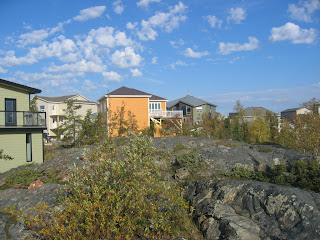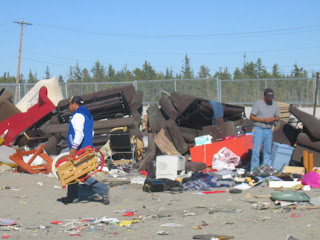The Yellowknife Dump
A rite of passage for living in Yellowknife surely has to include a trip to The Dump. That's why we (fibre friends) were properly horrified to hear that Donna had never been, in her twelve years in Yellowknife. "How about this Saturday?" I said. She doesn't have a car, so that's some excuse - but still. She was game, and so we went. Saturday afternoons, around 3:00 p.m., is reportedly a good time to go, since everyone who has had a garage sale that day brings what didn't sell.
The YK Dump is somewhat legendary for those of us who come from larger urban centres with very strictly controlled waste disposal. Last year in Calgary there was the "Slave Lake Toy Scandal" - employees of a certain company had raised money to buy toys for the fire-ravaged Alberta town, and through a mix-up said toys never reached their destination. Instead, they ended up being dumped, brand new in unopened packages. An alert Calgarian who happened to be there noticed, asked if he could salvage some of them - but the answer was "NO": once an item is brought to the dump, it becomes sacrosanct as waste, regardless of its condition or usefulness. Such would never happen in Yellowknife.
The Dump is approached in the usual manner: a line of vehicles, mostly
pickups bringing things, waiting to be let through the gate.
The approach is not without whimsy - Jiminy Cricket in the flowers, a bouquet on the stop sign:
After that, it's all "dump business," no effort to disguise or prettify. North American waste - perhaps waste anywhere in the world, except that we do significantly more than our share of it - isn't pretty. I think Yellowknife is honest to let people see the extent of what we throw away, and how ugly is the accumulation. And yet... there's a certain order, and some beauty in that order; and there's a certain thrill in salvaging a find and repurposing it for something useful.
If you want to just see what's there, as we were doing on this glorious Saturday afternoon, you tell the person in the booth: "just going shopping." You get waved through without further ado. On the immediate left is "the paint exchange" - cans get brought and taken, sometimes multiple times. Our friend Stefan is redoing his small Old Town house. "What colour are you painting it?" we asked. "That's under negotiation," he said, glancing at Sue. That negotiation isn't just the usual one between two people, but also includes what's available at The Dump. The paint for my loon came from here... Below some folks bringing, or taking - who knows?
Next to the paint are the appliances - again, a lot of bringing, but apparently some taking can be done as well.
Used antifreeze...
Turn the corner and on your right is the pile for used pallets and other wood... Yellowknife seems to have more pallets per capita than your average Canadian city, although that's my surmise rather than my known fact. If a person could think of a product to make with pallets, some serious money could be made!
In the pile were some of those glass blocks (which on closer inspection
turned out to be plastic), as well as an intriguing fence-like affair
with hinges that Donna and I thought hard about before deciding that no,
we really didn't know what to do with it. Here she is standing with the chipper behind her - it seems that at least some of the pallets get chipped (but what about the nails? must be quite the chipper...).
Across from the pallet pile there are tires, lots and lots and lots and lots of tires.
Where there are that many tires, can cars - vehicles generally - be far behind?
But the real fun of going to The Dump lies in exploring the area set aside for salvaging. People bring stuff to the three "cells" set aside for that purpose, and others - Donna and I - see what there is to be found. Some finds are legendary - a new Pfaff sewing machine still in its box - but there is also a lot of unsalvageable debris. Still, while we were there one person dropped off a dining room table with four chairs, for example; the set disappeared within minutes. In the second picture, Donna is about to tread carefully, in the third someone's found a perfectly good sled...
At the dump you can also access one of Yellowknife's municipal compost bins:
There's a place where paper is compacted:
Finally, somewhat unique to Yellowknife (and, no doubt, other Northern communities) are oil tanks, the kind that are used to store the oil needed to heat houses.But take a look at what someone did with one of them! (second picture). An admirable "Trashformation," one of the entry categories for the late-September Arts Week.
Well - on this trip I myself found a rack to hold my spools of thread, and I picked up some paint ("Picnic Day," a lovely green) for the dresser I got from Donna BEFORE she brought it to The Dump, as she had intended. Certainly I'm getting into the spirit!
























































